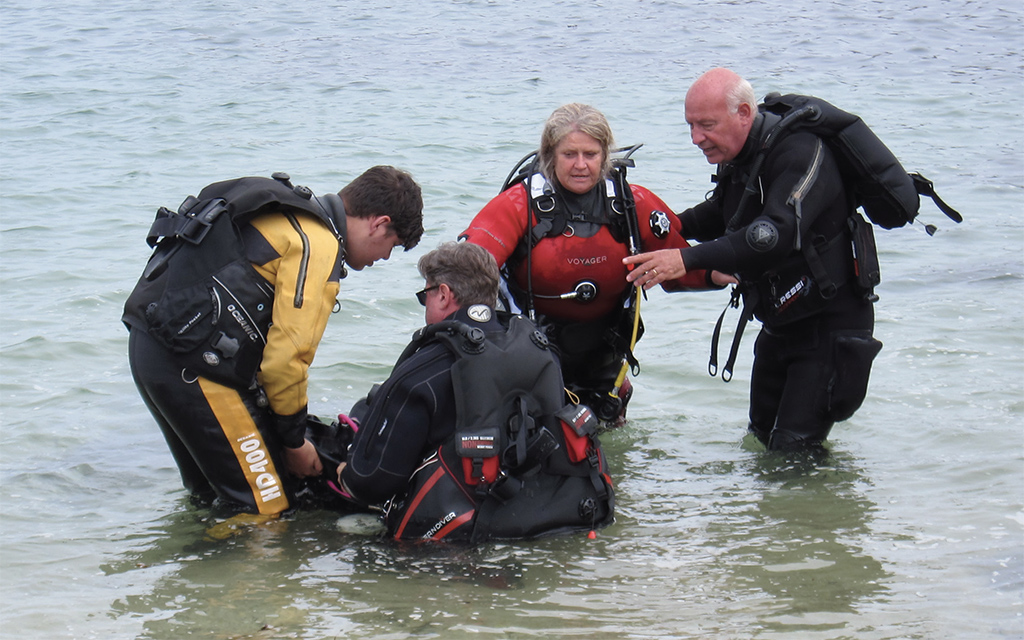
Some truly dedicated acting made for an especially compelling Practical Rescue Management course for Sub C Divers. Chris Heywood reports.
Sub C Divers, based in Atherton near Wigan, recently held a Practical Rescue Management (PRM) course. Seven Sports Divers attended, allowing them to complete four parts of their Dive Leader training. The course was split over two days, with theory lessons on Saturday held in a room at the Lancashire Powerboat Racing Club. Sub-C has a great relationship with the powerboat club, as some of our members have become trained powerboat rescue divers with them. The practical parts of the PRM course took place at Mackenzie Pier, Holyhead Harbour, a great venue for training due to its shallow and gentle shelving beach and quiet surroundings.
We had two newly qualified Ocean Divers assisting us, which meant we could form three teams of three. Three scenarios had been devised, enabling each of the students to manage at least one scenario. As the Ocean Divers didn’t yet have the training or skills required to manage a rescue, two of the Sports Divers were able to lead two scenarios.
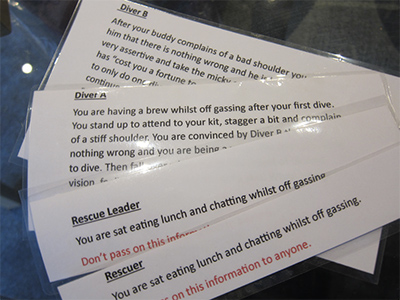 I created three scenarios for the teams to manage. Other club members served as ‘actors’ to support the event. All the actors received an outline and a script for the scenario they were assigned to, which would help them get into character a couple of weeks before the event. They were given their full scripts and directions printed on laminated cards on the day. Our actors then set themselves up with their equipment and took their starting positions.
I created three scenarios for the teams to manage. Other club members served as ‘actors’ to support the event. All the actors received an outline and a script for the scenario they were assigned to, which would help them get into character a couple of weeks before the event. They were given their full scripts and directions printed on laminated cards on the day. Our actors then set themselves up with their equipment and took their starting positions.
At this point, the three students were given their direction cards, one as the rescue leader and the other two as rescuers. All script and direction cards included the instruction: ‘Do not discuss your instructions with fellow team members’.
Other helpers were given scripts with instructions such as ‘Get in the student’s way’... ‘Tell them they are doing it wrong’... ‘ Where is the telephone?’ What should I say?”... and ‘Take photographs of the victims’.
Scenario 1: Lifesaving with complications
Along with the obvious rescue demands, there were secondary issues that in the heat of the moment may be overlooked. In one of the scenarios, a diver carried out a CBL (Controlled Buoyant Lift) on her buddy, Liea, who was sick underwater and subsequently unconscious at the surface (after breathing contaminated gas). All eyes were, naturally, on the unconscious diver, but other misfortunes awaited.
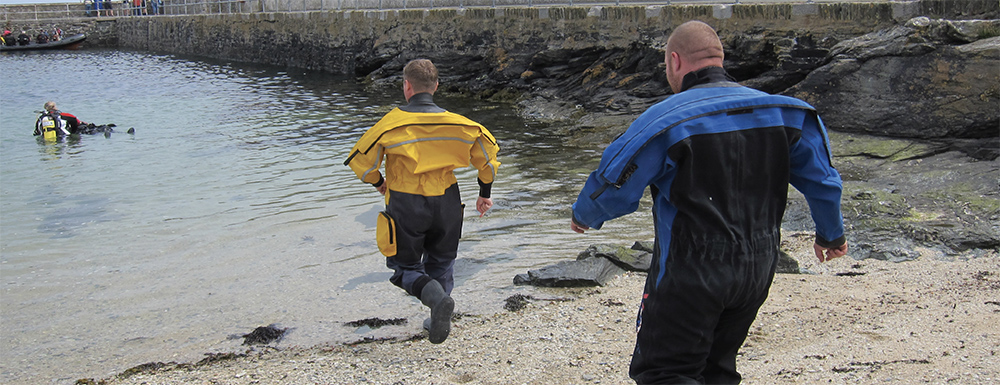
Quick! There's a diver in trouble!
Two rescuers were told to land the casualty, and a bystander was told to go and telephone for an ambulance. “I haven’t got a phone. Can I use yours and what do I say?” was the reply. Full instructions were then issued. While all this was going on, the diver who gave the CBL, Debbie, disappeared behind some nearby rocks.
Liea was then replaced with a manikin for BLS (Basic Life Support), including the use of a practice AED (automated external defibrillator). Putting all this together and breaking out the oxygen kit takes time, during which Liea miraculously started to regain consciousness. Coughing violently she asked: “Where is Debbie, my buddy?”
“Oh no... where is she?” replied the rescue manager, and after a brief search Debbie was found ‘unconscious’ behind the rocks. She was carefully picked up and moved next to Liea in the recovery position, so they could both use the twin hoses and masks on the O2 kit. The exercise was brought to a close and a full de-brief was conducted by Adam, the instructor and prompter for that scenario.
Scenario 2: RIB crash
The three students’ direction cards told them they were going out for a dive from the RIB. In the boat along with the students were Ian (the instructor for this scenario) Nick (actor) and John (cox). In Chris’s original plan, the cox was to shout out and pretend that the RIB had struck submerged rocks and stop the boat. As the boat stopped suddenly, the cox would bang his head on the windscreen and Nick (actor) would be thrown overboard, hurting his arm on the rocks.
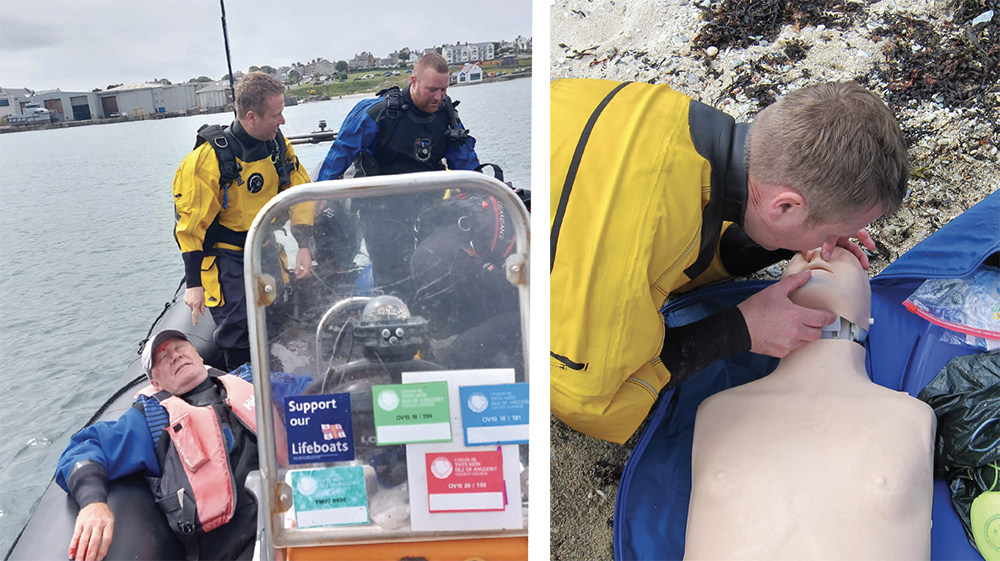
L: the coxswain, knocked out cold; R: basic life support
For Nick’s safety (being in the water) the engine would have to be stopped. As Chris had given out the plans to the actors two weeks previously, John was able to embellish the scenario plan, making the incident flow more realistically. He used a shot line with a buoy attached to simulate the rock, which meant he could pull the kill cord, lunge forward to ‘bang’ the windscreen, and at the same time slap fake blood over his face.
Hitting the buoy also gave Nick his cue to fall overboard without fear of getting in the way of the prop. The students then had two casualties, one of whom had to be recovered with a notional ‘broken arm’.
Scenario 3: One unconscious, one missing
In the third scenario, Amelia (actor) was seen floating face-down in the water. After she was de-kitted and checked for signs of life, CPR was started, along with administering oxygen (all done on a manikin). After five minutes, this prompt rescue proved successful and Amelia was brought back from the brink to ask, “How is Colin?”
“Who is Colin?” enquired one of the rescue team. “My buddy!” Amelia replied. So immediately we had to update the Coastguard that there was a lost diver as well as the unresponsive on we had reported earlier. Included in the update was the fact that she had now come around and was fully responsive, but still needed to be checked out in hospital. Here the scenario was ended and a de-brief was carried out led by Michael, our Diving Officer.
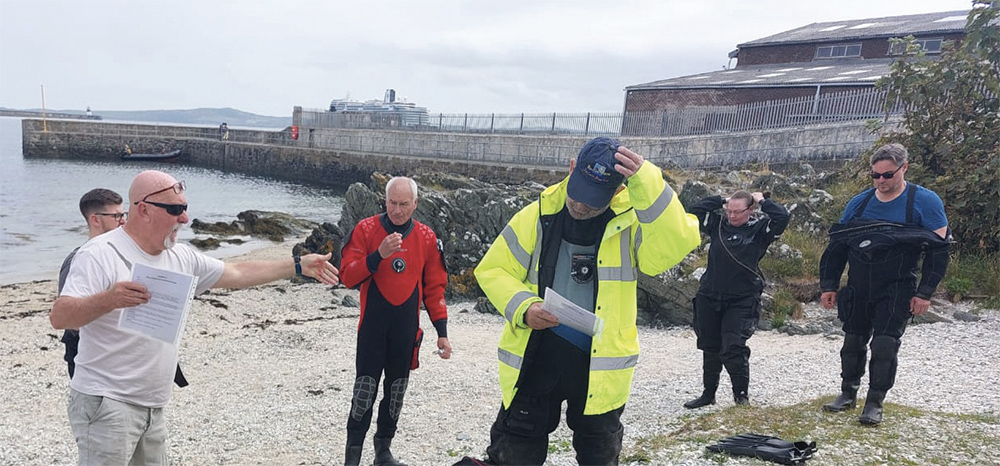
Chris gives the day's briefing and instructions
All in all, this was a great weekend with lots of learning for students and actors alike. Some of our actors hadn’t yet reached that stage in their training, but still appreciated the importance of prompt and effective diver rescue techniques. The last thing we did was to inform the Coastguard that we had finished our exercise. We had informed them prior to the event, as we didn’t want a concerned bystander ringing them up telling them that there was a bloke on a RIB in the harbour with blood all over his face.
Thanks to:
Contaminated gas actors: Debbie and Liea
Boat crash actors: Nick and John
Lost diver actor: Amelia
Bystander actors: Paula and Natalie
Course Instructors: Michael, Adam, Ian and Chris H
Helpers: Josh and Michael P
Students: Jonny, Carl, Derek, Danny, Melissa, Jeff, Stephen
Learning Curve article ‘Real world challenges’ by Chris Heywood first published in SCUBA magazine, Issue 149 October 2024.




